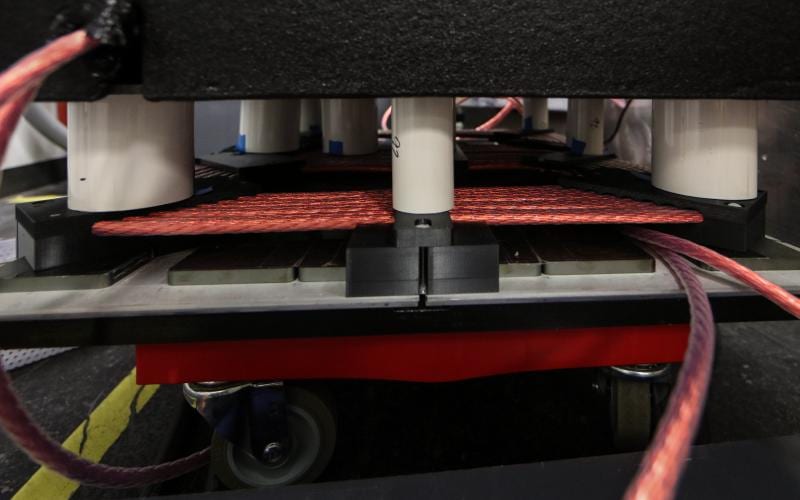Researchers Demonstrate 120-kV Wireless Charging System for Electric Vehicles
A wireless charging breakthrough demonstrated by the U.S. Department of Energy’s (DOE’s) Oak Ridge National Laboratory (ORNL) marks a leap toward allowing electric vehicles (EVs) to conveniently recharge within the same period that it typically takes to fill-up at a gas station.
Researchers at the national laboratory at Oak Ridge, Tennessee, in October said they demonstrated a wireless charging system that transfers 120 kW of power with a 97% efficiency—which is comparable to conventional, wired, high-power fast chargers. The laboratory demonstration transferred power across a six-inch air gap between two magnetic coils and charged a battery pack. The technology is a marked scale-up of the world’s first 20-kW wireless charging system, which ORNL created and demonstrated in 2016. That technology is being modified for applications such as commercial delivery trucks, ORNL said.
According to Veda Galigekere, project lead at ORNL’s Power Electronics and Electric Machinery Group, as researchers developed the 120-kW system, they deemed it “important to maintain the same or smaller footprint as the previous demonstration” to encourage commercial adoption. That’s why the team created a new coil design co-optimized with the latest silicon carbide power electronic devices for a lightweight, compact system. “We used finite element and circuit analyses to develop a novel co-optimization methodology, solving the issues of coil design while ensuring the system doesn’t heat up or pose any safety issues, and that any loss of power during the transfer is minimal,” he said.

Wireless breakthrough. The Oak Ridge National Laboratory’s unique wireless coils and power electronics are co-optimized to safely transfer large amounts of electricity across an air gap at 97% efficiency. Courtesy: Genevieve Martin/Oak Ridge National Laboratory, U.S. Department of Energy
The system essentially takes energy from the grid and converts it to high-frequency alternating current (AC), which generates a magnetic field that transfers across a large air gap. “Once the energy is transferred to the secondary coil, it is converted back to direct current [DC] and stored in a vehicle’s batteries,” ORNL explained.
The Fast-Charging Goal
The research, which is funded by the DOE’s Vehicle Technologies Office and performed at the DOE’s National Transportation Research Center at ORNL, is a leap toward the DOE’s “extreme” fast-charging goal to develop a system that delivers between 350 kW and 400 kW, while reducing charging time for EVs to 15 minutes or less. While ORNL’s researchers are now exploring increasing the power transfer level to 200 kW and eventually 350 kW, the laboratory said it is also refining dynamic wireless charging technology, which would allow EVs to automatically charge using wireless charging pads installed under roadways. “The goal is dynamic charging at highway speeds,” Galigekere said.
The development is also a boon for EV adoption, which experts generally agree could surge over the next decade. Global consultancy group Wood Mackenzie in August projected that while EV sales comprised less than 1% of annual vehicle sales in 2016, EV sales could make up 11% of new vehicle sales by 2030, owing largely to falling battery prices, government mandates and incentives, and ride sharing. However, it noted: “The infrastructure to support widespread EV usage and the subsequent electrification of transportation, like the demand for EVs themselves is still materialising.” Yet, the group is optimistic that change will be “rapid.” It estimates that 12 million residential charging points and 1.2 million public charging points could be installed in North America by 2030. Europe could see similar trends.
Going Wireless
Experts noted existing technology to charge EVs at “normal” speeds (of less than 22 kW) widely relies on AC charging, but there appears to be a gradual shift toward higher power options as EV batteries get bigger and consumer demand surges. Rapid charging, which can only be used on vehicles with that capability, can today supply DC or AC to recharge a car to 80% in 20 to 40 minutes. For example, while non-Tesla rapid DC chargers can provide power at 50 kW, Tesla’s Supercharger network allows Tesla cars to charge at up to 120 kW.
Meanwhile, alternative charging technologies such as battery swapping, wireless charging, rapid bus charging, and supercapacitors are not yet commercially viable on a large scale. Wireless charging, specifically, is of interest because users no longer must plug in every time they want to charge a car. Nearly all automakers have been pursuing wireless charging for several years, working to address several complex operational and safety issues. Meanwhile, industry stakeholders are also working to standardize acceptable criteria for interoperability, electromagnetic compatibility, minimum performance, safety, and testing. However, though the convenience and efficiencies of wireless charging makes it a plausible replacement for traditional wired charging, for now the consensus is that it is unlikely that wireless charging will have a high market penetration in the immediate future.
The post Researchers Demonstrate 120-kV Wireless Charging System for Electric Vehicles appeared first on POWER Magazine.